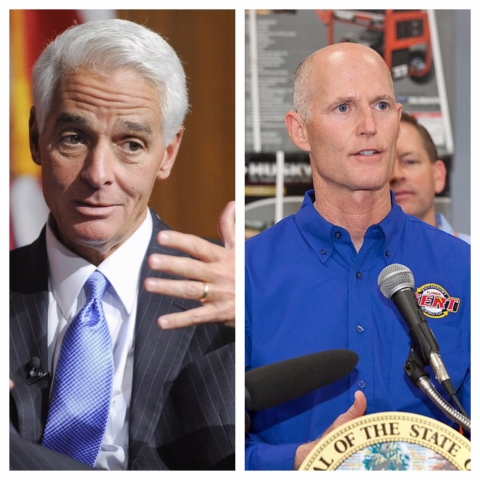How Close is Too Close: When Might Florida Returns Mean a Scott-Crist Recount?

by: Lorran Hart
The Florida governor’s race between incumbent Republican Rick Scott and Republican-turned-Democratic challenger and former-Governor Charlie Crist is predicted to be a close one, and could easily fall within the difference necessary for a recount. Four years ago, Scott defeated Democrat Alex Sink by a 1.2% margin. Despite the small disparity, it was not small enough to require a recount. Might this year be different?
As a consequence of the 2000 presidential election, the word “recount” gained a negative connotation in Florida politics and around the nation. The retabulation of votes between George W. Bush and Al Gore lasted for weeks, and the results were not finalized until the Supreme Court ruled to end the recounting process. Bush was ultimately declared the victor in Florida by a margin of 537 votes, giving him the presidency.
The state abandoned the “hanging chads” that proved problematic during the 2000 election, when the state reformed its electoral processes. Florida replaced the punch-card system, which yielded the chad problem, by a touch-screen process. However, the state has since discarded that method as well, and currently relies on “optical scan ballots.” With this system, voters fill in a circle near the name of the candidate of their choice, and then the ballots are processed through an electronic voting machine. Florida officials retain the ballots after scanning in case a recount is necessary.
The Florida Secretary of State, who is appointed by the Governor, is in charge of procedures regarding recounts. According to Florida election law, if unofficial returns show a margin of difference of 0.5% or less of the votes cast for a federal, state, or multi-county office, the Secretary must order a recount. Recounts are not absolutely mandatory; the candidate with the losing percentage of the votes can request that the recount not occur.
Once the Secretary of State orders a recount, the first step is then for a machine recount, which essentially checks the previous totals. If the automated recount changes the margin of difference between the candidates to .25% or below, a manual recount is then required. In particular the manual recount will include “undervotes” and “overvotes” that the machine may not have tabulated. “Undervotes” occur when an elector does not choose anyone for the office. “Overvotes” occur when a voter marks more than person for an office. It is possible that undervotes are intentional if the voter does not want to choose anyone for the office, but manual counters will decide if the voter did try to vote and the machine just did not count it.
While opinions may vary on the possibility of such a close outcome, candidates for each side nonetheless have legal teams on stand-by in preparation. Steve Geller, a Crist advisor, stated that, “We’re prepared." He continued to remark that “there have been emails going back and forth among our teams . . . There’re already plans in place.” Additionally, George LeMieux, a Scott supporter and board member at the Gunster law firm said that Republicans, too, have a legal team prepared just in case returns fall within the recount margin.
In 2010, Florida had a voter turnout of just under 50%. With 12 million voters currently registered, a similar turnout this year would yield about 6 million votes. Such an anticipated turnout would require around a 30,000 vote difference between the two candidates to trigger a recount.
Ultimately, even if the margin of victory is above the .5% threshold, a victor may not be certain until long after Tuesday night. In 2010, the winner of the Florida governor’s race was not decided until the following morning. If a recount is required, it may not be until November 18th (the deadline for certifying the final results) that Floridians have a definite answer to who their chief executive will be for the next four years.
